The giant of the ocean, the whale, is known as the largest mammal on earth. Its enormous length and weight are incredible. So, do you know which whales are the largest in the world? This article will take a look at the top ten giant whale species for you one by one. They are blue whales, fin whales, bowhead whales, right whales, sperm whales, humpback whales, gray whales, sei whales, killer whales and wire-armed whales. It is worth mentioning that the blue whale is not only the largest whale, but also the largest animal in the world and the largest known mammal on earth. So how big are the other whales? Let’s find out together.
1. Blue whale (33 meters)

Blue whale died due to ship collision
The blue whale is not only a giant among cetaceans, but also the largest living animal and the largest known mammal. Its body length is generally between 22 and 33 meters, and its weight is approximately 150,000 to 180,000 kilograms. Simply put, it weighs as much as 25 African Elephants-Are-Endangered.html">elephants combined, or 2,000 to 3,000 humans. The size of the blue whale is unimaginable. The tongue alone weighs 2,000 kilograms, the skull weighs about 3,000 kilograms, the liver weighs about 1,000 kilograms, the heart weighs about 500 kilograms, and its blood circulation volume is as high as 8,000 kilograms.
2. Fin whale (25 meters)
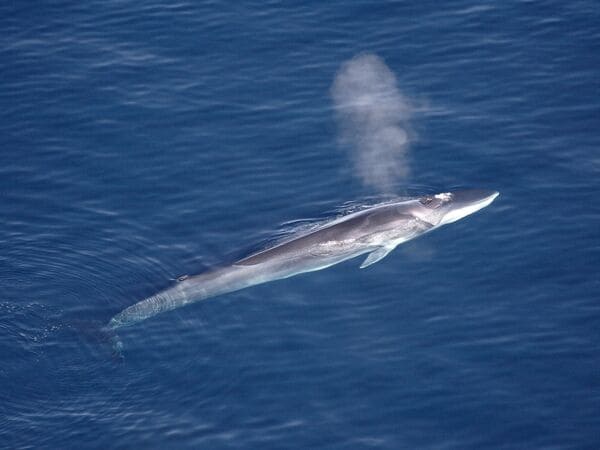
Fin whales, also known as baleen whales, fin whales or baleen whales, are an aquatic mammal in the genus Baleen whales. It is the second largest cetacean in the world and the second largest living animal after the blue whale. Fin whales are spindle-shaped, with an average length of about 25 meters and a weight of about 70 tons. The largest individuals among females and males can reach a length of 26.8 meters and a weight of 86.1 tons. In comparison, the average length of females captured in China was 20.3 meters and the average length of males was 18.4 meters. Fin whales usually move alone or in groups of 2 or 3. In summer, they migrate to cold waters to feed, and in winter to warm waters to breed. They are mainly found in Antarctic waters.
3. Bowhead whale (21 meters)
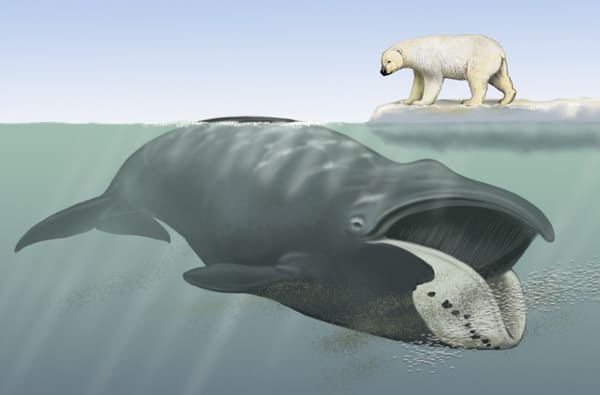
The length of the bowhead whale is about 21 meters and the weight reaches 190,000 kilograms. Females are larger than males. They are dark in color, have no dorsal fin, have a narrow upper jaw and an arched lower jaw. Bowhead whales have baleen that is up to 3 meters long, one of the longest of any species of their kind. They use these baleen to filter small animals in the water. When the sun shines, the baleen often reflects green fluorescence. Bowhead whales have powerful vocals that they use to communicate with each other during migration, feeding and socializing. Some of these long, repetitive whale songs may be one of their mating signals. Some individuals can even survive to be 150 to 200 years old.
4. Right whale (18 meters)

Right whales refer to a class of cetaceans belonging to the order Cetaceans, suborder Baleen whales and the family Right Whales. Their bodies are spindle-shaped, with smooth and hairless bodies. Adults can reach up to 18 meters in length and weigh up to 100 tons. Their bodies are mostly black and they have a special crust on their heads that gives them rough, speckled skin. Right whales are large in size, with a short and fat body and a head slightly larger than a quarter of the body length. Their whiskers are very long, narrow and soft, with 220 to 260 whiskers on each side. The whiskers can be up to 2.9 meters long. Both the whiskers and the whiskers are black. Right whales are mainly distributed in the Pacific and Atlantic waters, and can also be seen in the South China Sea, East China Sea and Yellow Sea in China.
5. Sperm whale (18 meters)
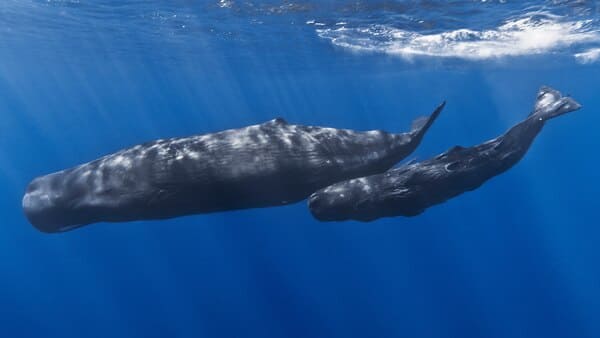
The sperm whale is a huge toothed whale, with a body length of up to 18 meters and a weight of more than 50 tons. In their body structure, the head is unusually heavy and wide relative to the body, with the largest brain in the animal kingdom, while the tail is relatively light and small, making the sperm whale's body shape similar to a giant tadpole. This proportion gives them a unique and eye-catching appearance. Sperm whales are widely distributed in ice-free seas around the world. They can be found in ice-free seas from the equator to the poles. Sperm whales have extremely strong diving abilities and are the mammals with the longest diving depths and longest diving times.
6. Humpback whale (18 meters)

Although the humpback whale is not the largest whale in the world, it is still a huge and mammoth presence in the ocean. They are large and obese. The average adult body length is about 12.9 meters for males and 13.7 meters for females. The largest recorded female reaches 18 meters and weighs between 25 and 30 tons. Humpback whales are known for their leaping posture, extra-long forewings and complex calls. They usually move in pairs or pairs, have a docile temperament, and like to swim, although they swim slowly. The main food of humpback whales is small crustaceans and small fish that swim in schools. They inhabit all the world's oceans, including China's Yellow Sea, East China Sea and South China Sea.
7. Sei whale (15-16 meters)

The body of the sei whale is relatively slender and streamlined, with a body length of about 15 to 16 meters, and the head length is about a quarter of the body length. Sei whales in the Southern Hemisphere can reach a maximum length of 20 meters, while those in the North Pacific have a maximum length of 18.6 meters. They are similar in size to fin whales, Bryde's whales, and lesser Bryde's whales, and their dorsal fins are also similar in shape. The main distinguishing feature is that there is a raised longitudinal ridge in the center of the back of the head of the sei whale, while there is no longitudinal ridge on the back of the head of the fin whale, and there are three longitudinal ridges on the back of the head of Bryde's whales. Sei whales are oceanic whales and are uncommon in coastal waters. They are found in both the southern and northern hemispheres and can be found from the tropics to the polar regions, but are more common in temperate waters at mid-latitudes than other baleen whales.
8. Gray whale (10-15 meters)
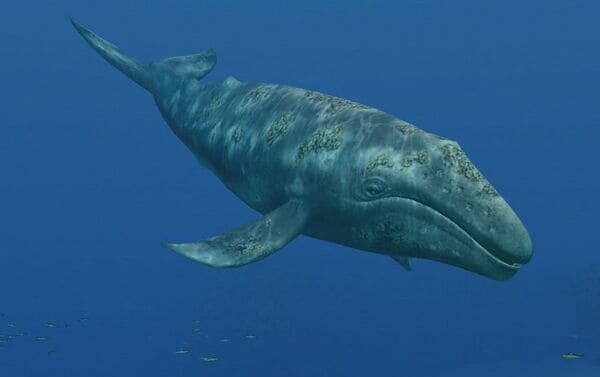
Gray whales belong to the family Cetacea, suborder Gray Whales, and are larger than other species in the family Cetacea, but smaller than right whales. The body length of an adult gray whale is about 10 to 15 meters (female whales are slightly larger than male whales), and the maximum weight can exceed 35 tons. Their body shape is spindle-shaped, with a thicker trunk, thickest near the flippers, and gradually tapering toward the tail. Young gray whales are dark gray, while adults are brownish gray to light gray. They have light-colored spots scattered across their bodies, as well as white to orange-yellow patches composed of whale lice and barnacles. The patches formed by these ectoparasites have become a characteristic feature of gray whales.
9. Horse-armed whale (10 meters)

The baleen whale is a baleen whale with a length of about 10 meters and a weight of about 7 tons. Their bodies are slender and they are the smallest of the baleen whales, with a total number of approximately 200,000. Horse-armed whales have the habit of migrating north and south. They usually swim to low-latitude waters in winter and spring, and migrate to high-latitude waters to feed in summer and autumn. They like to swim alone or in groups of 2 to 3, and generally do not form large groups. The swimming speed of the horse-armed whale is approximately 5 to 7 knots. The mist they emit when they exhaleThe column is small and low, generally only 1.5 to 2 meters high, and the tail will not come out of the water when diving. The main food of the bonnet whale consists of planktonic crustaceans such as krill and mysid shrimp, as well as some small fish that form schools.
10. Killer whale (8-10 meters)
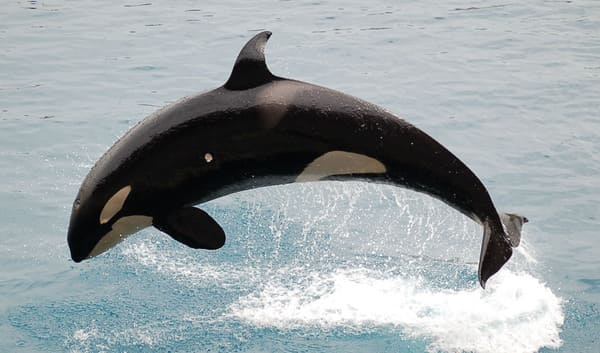
The killer whale is a large toothed whale of the dolphin family, with a length of about 8 to 10 meters and a weight of about 9 tons. It is one of the largest species in the family Delphinidae, with a slightly rounded head and no obvious beak. Killer whales are highly social animals that form families in groups. These families are considered to be one of the most stable family forms in the animal kingdom. Killer whales exhibit a complex range of social behaviours, hunting techniques and vocal communication, which are seen as evidence that killer whales have a unique culture. Killer whales are widespread and can be found in almost all ocean regions, from equatorial regions to polar waters.
The ranking of the ten largest whale species in the world is mainly based on referring to relevant websites, collecting information on various whale species, collating their body length and weight data, and then sorting according to body length. This ranking is for reference only. If you have any questions, please leave comments or criticisms at the end.
animal tags: Whale
We created this article in conjunction with AI technology, then made sure it was fact-checked and edited by a Animals Top editor.